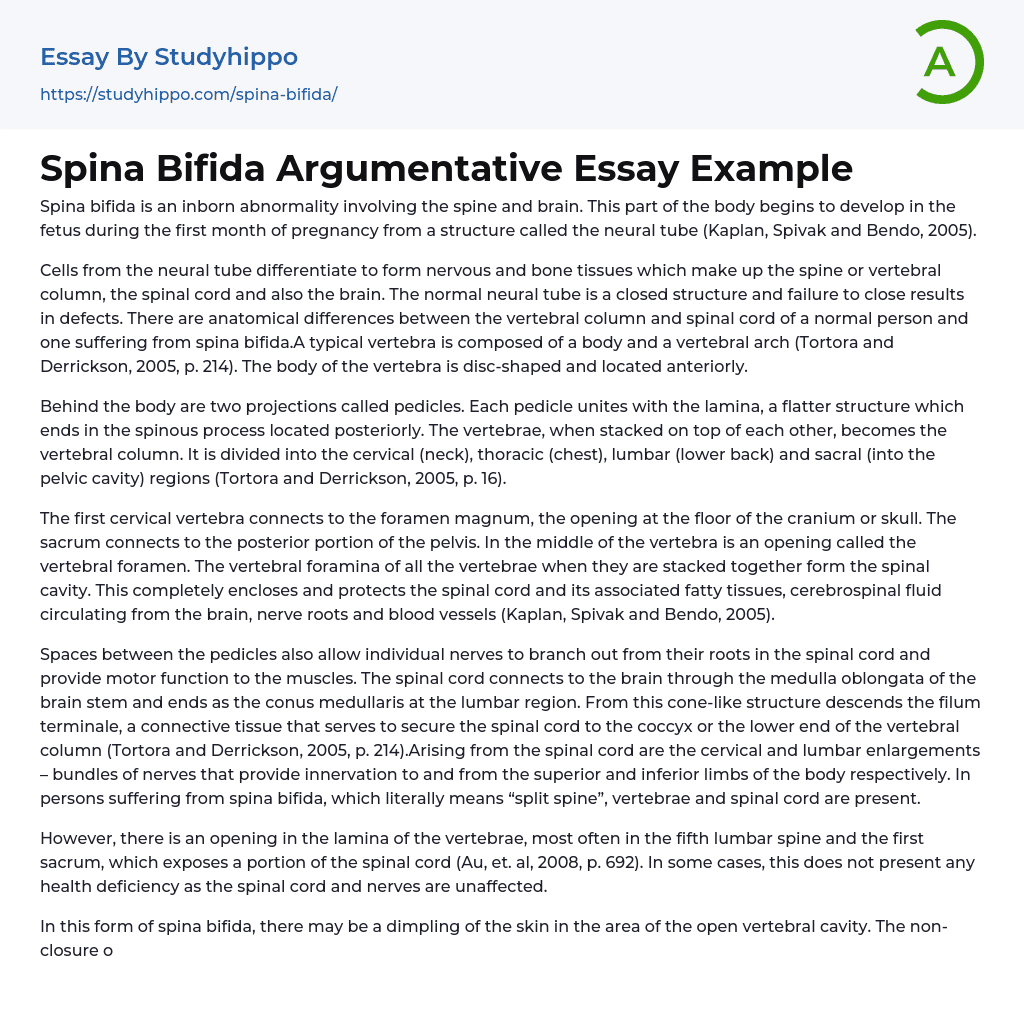According to Kaplan, Spivak and Bendo (2005), spina bifida is a birth defect that impacts the spine and brain. This anomaly arises during fetal development within the first month due to problems with the neural tube structure.The neural tube plays a role in generating nervous and bone tissues for the spine, spinal cord, and brain. If it fails to close properly, it can result in anatomical differences such as spina bifida affecting the spinal cord and vertebral column. A vertebra usually comprises a disc-shaped body at its front along with a vertebral arch (Tortora and Derrickson, 2005, p. 214).The body has two back projections called pedicles that connect with the flattened structure known as lamina. The lamina ends in the spinous process located at the back. When vertebrae stack together, they form the vertebral column which has regions including cervical, thoraci
...c, lumbar and sacral areas. (Tortora and Derrickson, 2005, p. 16).
Kaplan, Spivak, and Bendo (2005) explain that the first cervical vertebra connects to the foramen magnum at the skull's floor, while the sacrum connects to the posterior section of the pelvis. When piled together with other vertebrae, each vertebra's middle houses the vertebral foramen which forms a spinal cavity. This enclosed space completely protects fatty tissues, blood vessels, nerve roots, cerebrospinal fluid from the brain and spinal cord.
The spinal cord enables nerves to extend through the gaps between pedicles, providing motor function to muscles. It is connected to the brain via the medulla oblongata of the brain stem and terminates at the lumbar region's conus medullaris. The filum terminale, a connective tissue, attaches it to the coccyx or lower end of the vertebral column (Tortor
and Derrickson, 2005, p. 214). Furthermore, cervical and lumbar enlargements emerge from the spinal cord in bundles of nerves that provide innervation to limbs. In people with spina bifida or "split spine," vertebrae and spinal cord are present.
A gap in the lamina of the vertebrae, primarily in the fifth lumbar and first sacrum, reveals a section of the spinal cord (Au, et. al, 2008, p. 692), which may not have any negative effects on nerves and the spinal cord.
Spina bifida can take the form of a skin dimpling around an open vertebral cavity caused by unclosed laminae. This unclosure allows for the protrusion of the spinal cord's meninges or the spinal cord itself instead of following the spinal cavity's length. The baby may display this condition as a cyst-like sac on their lower back or an open lesion that exposes the vertebral cord and nerves (Nanigian et al., 2008, p. 1771).
The impacts of nerve damage vary depending on the degree of damage. If only the lower limbs are partially affected, it can lead to paralysis and loss of control over bladder/bowel functions (Brislin, 2008, p.34). Spina bifida can cause the cerebellum to shift position resulting in Arnold Chiari II malformation which is the collision between brain stem and spinal cord (Williams, 2008). The cerebrospinal fluid flows through the ventricles of the brain before finally being emptied into the spinal cord via brain stem.
Obstruction of drainage during ramming results in the accumulation of cerebrospinal fluid within the brain, leading to elevated pressure and subsequent enlargement of the skull.
- Central Nervous System essays
- John Locke essays
- 9/11 essays
- A Good Teacher essays
- A Healthy Diet essays
- A Modest Proposal essays
- A&P essays
- Academic Achievement essays
- Achievement essays
- Achieving goals essays
- Admission essays
- Advantages And Disadvantages Of Internet essays
- Alcoholic drinks essays
- Ammonia essays
- Analytical essays
- Ancient Olympic Games essays
- APA essays
- Arabian Peninsula essays
- Argument essays
- Argumentative essays
- Art essays
- Atlantic Ocean essays
- Auto-ethnography essays
- Autobiography essays
- Ballad essays
- Batman essays
- Binge Eating essays
- Black Power Movement essays
- Blogger essays
- Body Mass Index essays
- Book I Want a Wife essays
- Boycott essays
- Breastfeeding essays
- Bulimia Nervosa essays
- Business essays
- Business Process essays
- Canterbury essays
- Carbonate essays
- Catalina de Erauso essays
- Cause and Effect essays
- Cesar Chavez essays
- Character Analysis essays
- Chemical Compound essays
- Chemical Element essays
- Chemical Substance essays
- Cherokee essays
- Cherry essays
- Childhood Obesity essays
- Chlorine essays
- Classification essays




